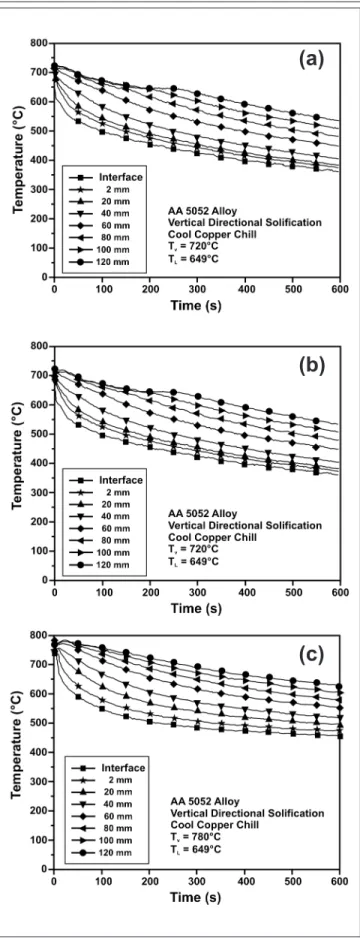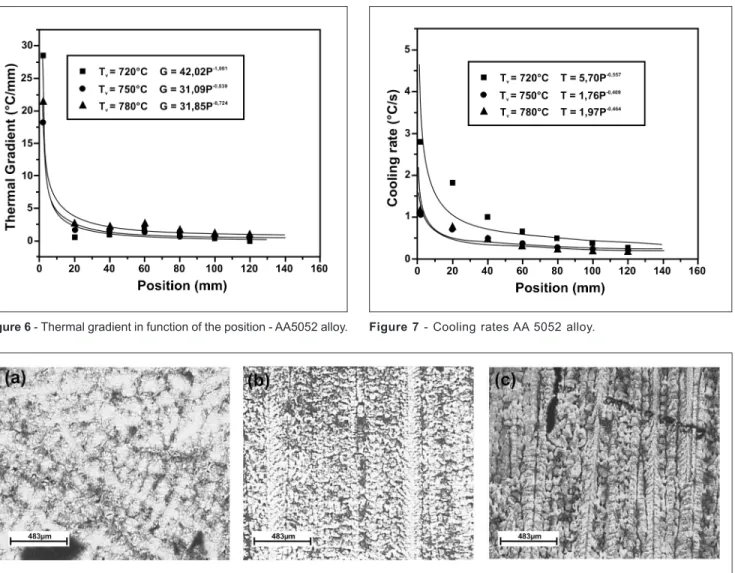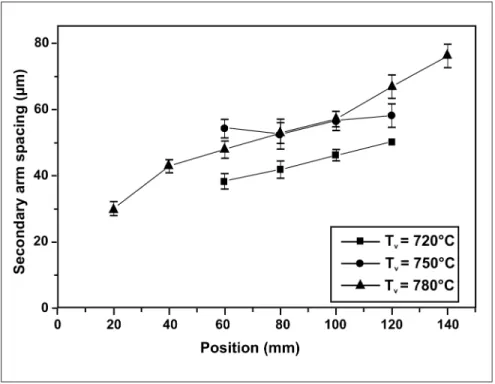Jean Robert Pereira
Rodrigues
Dr., State University of Maranhão -Center of Science Technologies, Department of Mechanical Engineer E-mail: jrobert@cct.uema.br
Tonnyfran Xavier de Araujo
Sousa
M.Sc., Refinery - ALUMAR E-mail: tonnyfran.sousa@alcoa.com.br
Ricardo Batista de Andrade
M.Sc., State University of Campinas -Department of Materials Science, Mechanical Engineering Faculty E-mail: ricardo@fem.unicamp.br
Rezende Gomes dos Santos
Dr., State University of Campinas -Department of Materials Science, Mechanical Engineering Faculty E-mail:rezende@fem.unicamp.br
Mírian de Lourdes Noronha
Motta Mello
Drª., IEM, Federal University of Itajuba (UNIFEI), E-mail: mirianmottamelo@unifei.edu.br
Metalurgia & Materiais
Overheating influence on
solidification - thermal
variables and microstructure
formation of aluminium alloy
(Influência do superaquecimento nas variáveis
térmicas de solidificação e na formação da
microestrutura de ligas de alumínio)
Resumo
O objetivo do trabalho é o desenvolvimento de uma análise comparativa do processo de solidificação da liga de alumínio com diferentes taxas de superaquecimento. Os principais parâmetros de solidificação foram determinados experimentalmente afetados pelo grau de superaquecimento e sua influência na formação da microestrutura. Foi escolhida a liga de AA5052 contendo 3% de magnésio pelo seu interesse comercial. A liga foi vazada com três diferentes graus de superaquecimento, em um dispositivo que permite a solidificação unidirecional e o monitoramento, através de um sistema de aquisição de dados, das variações de temperatura em diferentes posições da peça. A partir dos resultados de temperatura são determinados outros parâmetros do processo. Os espaçamentos interdendríticos são determinados a partir das micrografias. Através da análise experimental, é determinada a influência do grau de superaquecimento nos seguintes parâmetros relativos ao processo de solidificação: coeficiente de transferência de calor na interface metal/molde, velocidade de avanço da frente de solidificação, gradiente de temperatura em frente à isoterma liquidus, taxa de resfriamento, tempo local de solidificação e espaçamentos interdendríticos primário e secundário. Também é analisada a transição entre a estrutura colunar e equiaxial.
Palavras-chave: Solidificação unidirecional, ligas de alumínio, superaquecimento.
Abstract
a data acquisition system. From the temperature results, the other parameters of the process were determined. The dendritic spacing was determined by the micrographs. Through experimental analysis, the influence of the overheating range was established at the following parameters related to the solidification process: the heat transfer coefficient at the metal/mold interface, the solidification rate, the thermal gradient at the liquidus isotherm, the cooling rate, the local solidification time and secondary arm spacing. The change between the columnar and equiaxed structure was also studied.
Keywords: Unidirectional solidification, 5052 Aluminium alloy, overheating.
1. Introduction
Magnesium is the lightest of all the metals used as a basis for constructional alloys. It is this property that entices automobile manufacturers to replace denser materials, not only steels, cast irons and copper base alloys but even aluminium alloys, by magnesium-based alloys (Mordike and Ebert, 2001).
The melted sample characteristics depend on the thermal parameters for solidification, such as the velocity at which the dendrite tip advances, the thermal gradient at the liquidus isotherm, the cooling rate and the local solidification time. These parameters directly affect the microstructure arrangement and, as such, it is important to study their variation in relation to alloy solidification.
In metallic alloy solidication, the most usual solid growth morphology is dendritic formation. A dendritic structure is an arrangement of primary, secondary, tertiary, and occasionally higher degree branches, which results in an intricate array where the spaces between the dendrite arms are occupied by eutectic or intermetallic structures. Dendritic growth investigations are of
considerable importance in metallic alloy solidification because the dendritic microstructure plays a notable role in porosity distribution and mechanical properties of foundry and cast products (Garcia, 2001).
The 5052 aluminium alloy, containing about 3% Magnesium, was selected since it is used for commercial purposes. Alloys from the Al-Mg group are ductile in the annealed state, but they harden quickly when cooled, have excellent weldability and high corrosion resistance in maritime environments. As applications, they are used for: shutters, boats, signs, automobile bodies and stamping for general use (Alcan Catalogue, 2005).
In this work, the unidirectional solidification of the 5052 aluminium alloy was performed within three different overheating ranges; 720ºC, 750ºC e 780ºC. Their relevance with the previously-mentioned thermal parameters and also their influence on column zone size are presented. Based on analysis ease, experiments that furthered unidirectional solidification allowed identification of the interdendritic spacing, as well as its relation with the solidification parameters. With this data, it was possible to make an analogy with other solidification methods. The primary dendritic arms at the columnar structures and grain boundary were aligned.
2. Experiments
The alloy used in this experimental work was the 5052 aluminium alloy containing about 3% magnesium, whose composition is presented in Table 1.
The aluminium alloy was melted in an electric resistance furnace under three different overheating ranges, 720ºC,
750ºC and 780ºC, respectively. It was then poured into a- unidirectional solidification device, previously pre-heated to the respective fusion temperatures with the objective of avoiding lateral heat loss. Before the pouring, the furnace was turned off, activating the cooling system.
The unidirectional solidification device, consists basically of a tubular furnace heated by four silicon carbide elements of the globar type, which is fit into an insulating ceramic mold of zirconia, measuring 280 mm length by 40 mm diameter. This is coupled over a water-cooled copper chiller. This device was designed so that heat extraction could be accomplished only from the bottom (cooled by water), furthering the vertical ascending unidirectional solidification. The temperature variations occurring during the solidification process were measured by thermocouples, inserted at different positions throughout the sample, coupled to an acquisition data system of 12-bit resolution and composed of 2 conditioning boards: the first had 16 type K thermocouples and the second, 16 type S thermocouples. The acquisition rate was 10 Hz per channel.
Afterwards, the sample was stripped and cut lengthwise. One half was utilized for macrograph analysis and the other half for micrograph analysis. The samples obtained were polished and etched properly to reveal their macro-and micro-graphs.
3. Results and
discussion
Figures 1(a), (b) and (c) demonstrate the temperatures acquired at the different points throughout the 5052 aluminum alloy sample unidirectionally
solidified at three different overheating ranges, 720ºC, 750ºC and 780ºC. The solidification time for the alloy at a 780ºC pouring temperature is long due to its elevated overheating range.
Figure 2 shows a variation of the heat transfer coefficient at the metal/chill interface determined by the inverse comparison method of experimental and numerical profiles for the 5052 aluminium alloy (Melo, 1996, 2005a, 2005b). From the comparative results, it is noticed that at a higher pouring temperature, the heat extraction efficiency is elevated. This occursbecause of the higher overheating variation, which permits faster and more intense heat exchange. So, therefore, the most elevated heat transfer coefficient was obtained with a pouring temperature of 780ºC.
The macrograph results of the performed experiments present a large extension of columnar grains, as a result of the unidirectional solidification, indicating the efficiency of the developed device.
Figures 3(a), (b) and (c) show the macrographs obtained from the 5052 aluminium alloy poured at 720ºC, 750ºC and 780ºC respectively. It is possible to see a progressive increasing of the columnar zone as long as the pouring temperatures increase. The extension of each columnar zone is: at 720º C-85mm, 750º C-110mm and 780º C-125mm. It is possible to visualize columnar grains up to the maximum length of 125mm at a pouring temperature of 780º C. The samples were etched by rubbing, using the following etchant for revealing their macrostructures: 20 mL glycerin, 30 mL HCl, 2 mL satured aqueous, FeCl3 solution, 7 drops HF and 1 mL of HNO3.
The temperatures and the time acquired from the files of the acquisition data system were utilized to determine the experimental thermal parameters.
The position of liquidus isotherm in function of time is a parameter that could be directly determined from the cooling Figure 1 - (a) Cooling curves for the 5052 aluminium alloy, 720ºC.
(b) Cooling curves for the 5052 aluminium alloy, 750ºC. (c) Cooling curves for the 5052 aluminium alloy, 780ºC.
Figure 2 - Heat transfer coefficient.
(a)
(b)
curves, which is shown in Figure 4. The solidification time is higher for the aluminium alloy poured at 780ºC due to its higher overheating range. As the pouring temperature of 720ºC is near of liquidus line, it is possible to perceive that the solidification time is less.
Figure 5 presents a variation of the velocity at which the dendrite tip advances in function of its position at the three overheating ranges. This parameter is obtained from the cooling curves corresponding to each thermocouple, accepting that the temperature on the dendrite tip is the same as the liquidus temperature (Pan and Loper Jr., 1990; Suri et al., 1994; Laurent and Rigaut, 1992; Melo et al., 2004).
In Figure 5, notice the decrease in the velocity at which the dendrite tip advances to positions that are further from the cooled chill. This is owing to increase of the solidified layer as the solidification process progressesand resistance to the heat flow occurs. So, a time (t’) is set, where the liquidus isotherm passes through the position corresponding to a determined thermocouple. Thetime (t”) indicates when it crossed the position corresponding to the next thermocouple. The two thermocouple distances (Dx) are
Figure 3 - Macrographs of 5052 aluminium alloy pouring at: (a) 720ºC, (b) 750ºC and (c) 780ºC.
Figure 4 - Variation curves of liquidus isotherm positions in function of time for the three different overheating ranges - AA 5O52 alloy.
Figure 5 - Variation curves of velocities at which the dendrite tip advances in function of position for the different overheating ranges - AA 5052.
divided by the time interval, so the velocity at which the dendrite tipe advances (ν) is acquired:
−
= (1)
Figure 6 presents the variations of thermal gradient at the liquidus isotherm for the three different overheating ranges. This figure shows a decreasing of the temperature gradients for the overheating ranges as the solidification advances, due to the gradual dissipation of overheated liquid metal.
The thermal gradient at the liquidus isotherm (G) is acquired by the difference between Tliq, which is the liquidus temperature corresponding to the position of a determined thermocouple, and T’ that is the temperature corresponding to the position of next thermocouple divided by Dx, which is
the distance between them, as it is seen below:
−
Through the velocities at which the dendrite tip advances (ν) and the thermal
gradients (G), the cooling rates during solidification were determined using the following relation:
⋅
= (3)
Comparatively analyzing the variation curves of the cooling rates for the studied aluminium alloy as shown in Figure 7, it is noticed that the rates were highest for the 5052 aluminium alloy poured at 720ºC, owing to the higher cooling velocity. As the solidification advances, the rates for the others overheating ranges lean toward proximate values due to overheating dissipation and consequent thermal gradient decreasing.
The micrographs were obtained for the three pouring temperatures from a longitudinal section in the middle of the columnar zone as shown in Figures 8(a), (b), and (c). The samples were etched by immersion using the same etchant as for the macrograph. Notice that the appearance of dendrites is more evident from the intermediate zone to the end of columnar zone and also with increasing overheating temperature.
The secondary dendrite arm spacings were experimentally measured along the columnar zone in function of the position for the three pouring temperature, as presented in Figure 9. At the pouring temperatures of 720ºC and
750ºC, it was more difficult to measure the dendritic secondary arm spacings in the beginning of columnar zone owing to their elevated refinement degree (Santos and Melo, 2005).
4. Conclusions
The acquired results in this work allow to conclude that the built unidirectional solidification device is efficient and obtains extended columnar zones of 85 mm, 110 mm and 125 mm for the respective pouring temperatures of 720ºC, 750ºC and 780ºC.
The solidification time for the pouring temperature of 780ºC is long due to its more elevated overheating range.
Figure 6 - Thermal gradient in function of the position - AA5052 alloy. Figure 7 - Cooling rates AA 5052 alloy.
Figure 9 - Secondary arm spacing. The most elevated heat transfer
coefficient was obtained at the pouring temperature of 780ºC.
It is possible to notice that the velocities at which the dendrite tip advances decrease with the increasing of the overheating range, being significantly faster for the lowest overheating range when compared with the highest overheating range, until in the end, the results become quite close.
The thermal gradient in front of liquidus isotherm increases with the elevation of the overheating degree, but the influence of the overheating was not significant in this parameter.
The cooling rate in front of the liquidus isotherm decreases with the increase of the overheating. In this case, a larger influence of the overheating is noticed when it is varied by 10% to 15% rather than by 15% to 20%, for which the results are very similar.
The dendrite secondary arm spacings increase with the overheating degree, being much lower for an overheating of 10% and very similar for overheating ranges from 15% to 20%.
5. Acknowledgements
The authors thank FAPESP, FAPEMA, CAPES and CNPq for their financial support in the development of this work.6. References
Aluminium Canada, 2005, Alcan catalogue, http://www.alcan.com.
GARCIA, A. Solidificação: fundamentos e aplicações. Campinas: Ed. da Unicamp, 2001. 399 p.
LAURENT, V., RIGAUT, C. Experimental numerical study of criteria functions for predicting microporosity in cast aluminium alloys. AFS Transactions, v.100, p. 647-655, 1992.
MELO, M. L. N. M. Análise numérico/experimental da formação de microporosidades durante a solidificação de ligas de Alumínio. Campinas: Faculdade de Engenharia Mecânica, Unicamp, 1996. 254 p. (Tese de Doutorado).
MELO, M. L. N. M., RIZZO, E. M. S., SANTOS, R. G. Numerical model to predict the position, amount and size of microporosity formation in Al-Cu alloys by dissolved gas and solidification shrinkage. Materials Science and Engineering A, v. 374, p. 351-361, 2004.
MELO, M. L. N. M., RIZZO, E. M. S., SANTOS, R. G. Prediction of dendrite arm spacing and its effect on microporosity formation in directionally solidified Al-Cu Alloy. Journal of Materials Science, v. 40, p. 1-11, 2005.
MELO, M. L. N. M., SANTOS, C.A., PENHALBER, C.A.L. Determinação numérico/ experimental do coeficiente de transferência de calor na interface metal/molde durante a solidificação do aço inoxidável AISI 304. Revista Matéria, 2005. Accepted for publishing.
MORDIKE, B.L., EBERT, T. Magnesium, properties-applications-potential. Materials Science and Engineering A, v. 302, p. 37-45, 2001.
PAN, E.N., LIN, C.S., LOPER, Jr, C.R. Effects of solidification parameters on thefeeding efficiency of A356 aluminium alloy. AFS Transactions, v. 98, p. 735-746, 1990.
SURI, V. K., PAUL, A. J., BERRY, J. T. Determination of correlation factors for prediction of shrinkage in castings - Part I: prediction of microporosity in casting; a generalized criterion.
AFS Transactions, v. 102, p. 861-867, 1994.
SANTOS, R. G., MELO, M. L. N. M. Permeability of interdendritic channels. England,
Materials Science and Engineering A-Structural Materials Properties Microstructure and Processing, v. 391, p. 151-158, 2005.
Artigo recebido em 29/11/2007 e aprovado em 04/08/2009.




